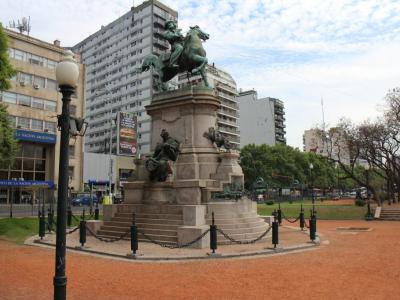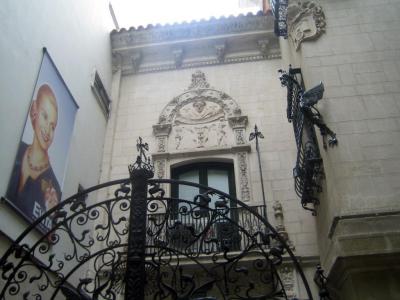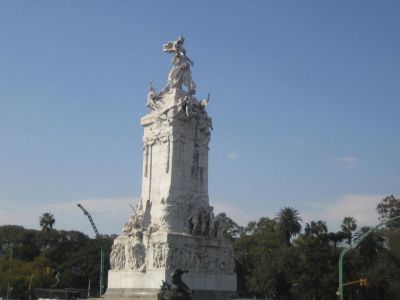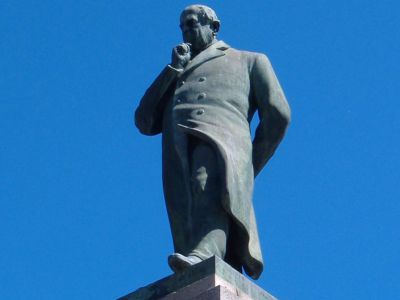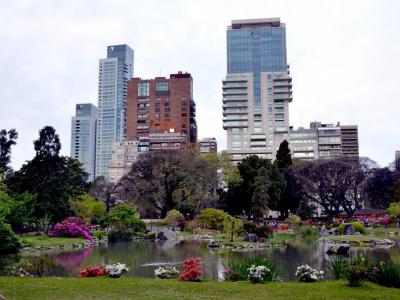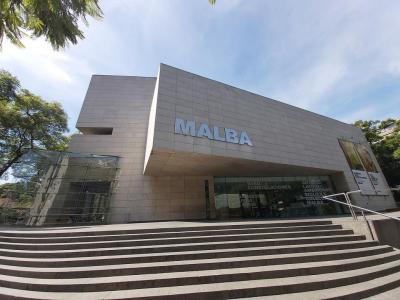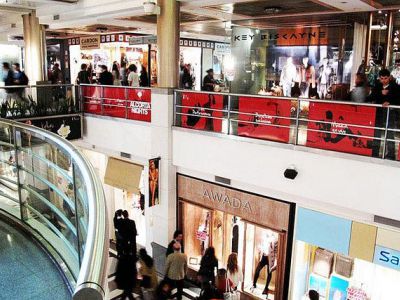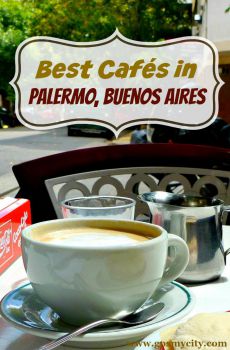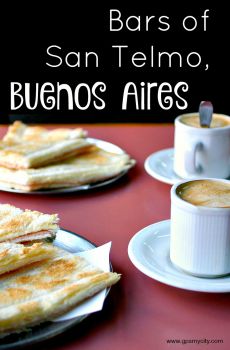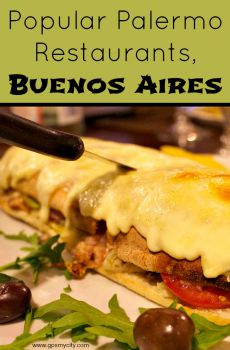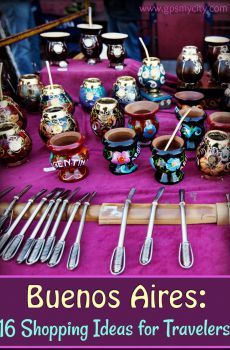Palermo Area Walking Tour (Self Guided), Buenos Aires
Situated just back from one of the main thoroughfares, Santa Fe Avenue (Avenida Santa Fe), Palermo is a relaxed and culturally delightful area full of restaurants, cafes, and wall murals. The tree-lined streets are shady and many of the older Spanish-style houses were converted into small shops without compromising their original character. It’s an excellent place in which to sample the city’s exotic fare, go on nature walks or people-watch, particularly from a cafe's pavement seating.
Once you’ve made it to Plaza Italia, you can enjoy the free-admission Botanical Garden – an oasis of tranquility in the middle of Buenos Aires. Well laid out, easy to navigate and with adequate seating to lunch or rest, it has quite a few 20th-century sculptures here and there as well. Only a block away from the Garden, the Evita Museum is a must-see for anyone who has been inspired by the amazing, yet rightly controversial Eva Perón – First Lady of Argentina and idolized by millions.
Also located in this area are one of the largest Japanese gardens outside of Japan (including a great sushi and seafood restaurant on the premises) and a more high-end quarter – the Palermo Chico, characterized by magnificent mansions, regal avenues, and exclusive apartment buildings; also home to the Museum of Latin American Art of Buenos Aires (MALBA), a favorite amongst locals.
Palermo has something for everyone, suiting all tastes and pockets, so follow this self-guided walking tour around its different locations – you will agree that it’s a great addition to the long list of Buenos Aires’ must-have experiences.
Once you’ve made it to Plaza Italia, you can enjoy the free-admission Botanical Garden – an oasis of tranquility in the middle of Buenos Aires. Well laid out, easy to navigate and with adequate seating to lunch or rest, it has quite a few 20th-century sculptures here and there as well. Only a block away from the Garden, the Evita Museum is a must-see for anyone who has been inspired by the amazing, yet rightly controversial Eva Perón – First Lady of Argentina and idolized by millions.
Also located in this area are one of the largest Japanese gardens outside of Japan (including a great sushi and seafood restaurant on the premises) and a more high-end quarter – the Palermo Chico, characterized by magnificent mansions, regal avenues, and exclusive apartment buildings; also home to the Museum of Latin American Art of Buenos Aires (MALBA), a favorite amongst locals.
Palermo has something for everyone, suiting all tastes and pockets, so follow this self-guided walking tour around its different locations – you will agree that it’s a great addition to the long list of Buenos Aires’ must-have experiences.
How it works: Download the app "GPSmyCity: Walks in 1K+ Cities" from Apple App Store or Google Play Store to your mobile phone or tablet. The app turns your mobile device into a personal tour guide and its built-in GPS navigation functions guide you from one tour stop to next. The app works offline, so no data plan is needed when traveling abroad.
Palermo Area Walking Tour Map
Guide Name: Palermo Area Walking Tour
Guide Location: Argentina » Buenos Aires (See other walking tours in Buenos Aires)
Guide Type: Self-guided Walking Tour (Sightseeing)
# of Attractions: 8
Tour Duration: 2 Hour(s)
Travel Distance: 3.5 Km or 2.2 Miles
Author: irenes
Sight(s) Featured in This Guide:
Guide Location: Argentina » Buenos Aires (See other walking tours in Buenos Aires)
Guide Type: Self-guided Walking Tour (Sightseeing)
# of Attractions: 8
Tour Duration: 2 Hour(s)
Travel Distance: 3.5 Km or 2.2 Miles
Author: irenes
Sight(s) Featured in This Guide:
- Plaza Italia (Italy Square)
- Botanical Gardens
- Evita Museum
- Spaniards Monument
- The Statue of Domingo Faustino Sarmiento
- Jardín Japonés (Japanese Garden)
- Museum of Latin-American Art of Buenos Aires (MALBA)
- Paseo Alcorta Shopping Center
1) Plaza Italia (Italy Square)
Plaza Italia is a square near the entrance of the city's Botanical Gardens and the Buenos Aires Zoo. Though the size of the square is small, it holds an important place in the history of Buenos Aires.
The square is a center of pedestrian and vehicular transportation. This is largely due to a metro station that is under the square, which is also called Plaza Italia. This is where the first electric tram in the city departed. Visitors can view a mosaic that marks the point where this historically significant event took place.
In the center of the square stands a statue of Italian hero Giuseppe Garibaldi. It was gifted to the city by a local Italian community. This is how the name of the square was changed from Plaza de los Portones to Plaza Italia.
Plaza Italia is a good stopping point on a visitor's way into the Botanical Gardens. They can rest on one of the park benches, enjoy the green grass or find a shady spot under one of the trees to take a break from the Argentine sun.
The square is a center of pedestrian and vehicular transportation. This is largely due to a metro station that is under the square, which is also called Plaza Italia. This is where the first electric tram in the city departed. Visitors can view a mosaic that marks the point where this historically significant event took place.
In the center of the square stands a statue of Italian hero Giuseppe Garibaldi. It was gifted to the city by a local Italian community. This is how the name of the square was changed from Plaza de los Portones to Plaza Italia.
Plaza Italia is a good stopping point on a visitor's way into the Botanical Gardens. They can rest on one of the park benches, enjoy the green grass or find a shady spot under one of the trees to take a break from the Argentine sun.
2) Botanical Gardens
The Buenos Aires Botanical Garden is located in the Palermo neighborhood of Buenos Aires. The 17-acre park holds more than 6,000 species of plants and trees. It is also home to public art and monuments.
The Botanical Garden was established in 1898 by French architect Carlos Thays. The main building of the garden, built in 1881, was the mansion where Thays lived with his family while he was designing the landscape.
Multiple regions are represented by the Botanical Garden. The Roman garden contains poplars, laurels and other Apennine mountain plants. The French garden is modeled after 17th and 18th century French landscaping trends. The garden also features plant life from Asia, Africa, Oceania and central Europe.
Visitors can take a self-guided tour of the Botanical Garden from 8 AM to 6:45 PM Tuesday through Friday and 9:30 AM to 6:45 PM on weekends. Spanish-speaking tours are available each Saturday and Sunday at 10:30 AM and 3 PM.
The Botanical Garden was established in 1898 by French architect Carlos Thays. The main building of the garden, built in 1881, was the mansion where Thays lived with his family while he was designing the landscape.
Multiple regions are represented by the Botanical Garden. The Roman garden contains poplars, laurels and other Apennine mountain plants. The French garden is modeled after 17th and 18th century French landscaping trends. The garden also features plant life from Asia, Africa, Oceania and central Europe.
Visitors can take a self-guided tour of the Botanical Garden from 8 AM to 6:45 PM Tuesday through Friday and 9:30 AM to 6:45 PM on weekends. Spanish-speaking tours are available each Saturday and Sunday at 10:30 AM and 3 PM.
3) Evita Museum
The Evita Museum was opened in 2002 to celebrate the life of Evita Perón. The museum is located in a beautiful mansion built in 1923 with Plateresque and Italian Renaissance influences.
The Fundación Eva Perón bought the mansion to use it as a temporary home for women and children in need. Evita Perón inaugurated the home in 1948.
Today, the building serves as the Evita Museum. Visitors can learn about and appreciate the life of one of Argentina's most important and influential women.
Eva, also known as Evita, was born into poverty in 1919. She married Juan Perón in 1944. When Perón became President of Argentina in 1946, Eva became the Frist Lady. She championed women's rights and was a voice for labor rights. She founded the first female-run political party, the Peronist Women's Party. In 1951, Eva announced her candidacy for Vice President of Argentina. In 1952, the Argentine Congress gave Eva the title of Spiritual Leader of the Nation. Eva Perón tragically died from cancer in 1952 at the age of 33.
Visitors can view Eva's stylish wardrobe, photographs from her life, and assorted memorabilia. You can view a video of her famous speech from the balcony of Las Casa Rosada.
The Fundación Eva Perón bought the mansion to use it as a temporary home for women and children in need. Evita Perón inaugurated the home in 1948.
Today, the building serves as the Evita Museum. Visitors can learn about and appreciate the life of one of Argentina's most important and influential women.
Eva, also known as Evita, was born into poverty in 1919. She married Juan Perón in 1944. When Perón became President of Argentina in 1946, Eva became the Frist Lady. She championed women's rights and was a voice for labor rights. She founded the first female-run political party, the Peronist Women's Party. In 1951, Eva announced her candidacy for Vice President of Argentina. In 1952, the Argentine Congress gave Eva the title of Spiritual Leader of the Nation. Eva Perón tragically died from cancer in 1952 at the age of 33.
Visitors can view Eva's stylish wardrobe, photographs from her life, and assorted memorabilia. You can view a video of her famous speech from the balcony of Las Casa Rosada.
4) Spaniards Monument
Monumento a La Carta Magna y Las Cuarto Regiones Argentinas is a large marble and bronze statue popularly known as the Spaniards Monument. It is located at the intersection of two large boulevards in Buenos Aires, the Avenida del Libertador and Avenida Sarmiento.
The Spanish monument was donated by the Spanish to the Argentines in 1910 to commemorate the hundred year anniversary of the May Revolution. A design competition was held and the winner was the Spanish sculptor, Agustin Querol. Querol and his successor Cipriano Flogueras died soon after work on the monument began. The Prince of the Asturias, the Spanish ship that was carrying the bronze and marble for the statue sank of the coast of Brazil in 1916. Finally, in 1927, the statue was completed and the Count of Amalfi gave the symbolic delivery on behalf of the Spanish King to the then President of Argentina.
The Spaniards Monument is 24.5 meters high and is made of brass and Carrara marble. It consists of the statue of liberty on a towering pedestal. It has a large frieze at the base and stands on a pool with fountains. The Bronze figures surrounding the statue are dedicated to the Argentine constitution and the four regions of the country.
The Spanish monument was donated by the Spanish to the Argentines in 1910 to commemorate the hundred year anniversary of the May Revolution. A design competition was held and the winner was the Spanish sculptor, Agustin Querol. Querol and his successor Cipriano Flogueras died soon after work on the monument began. The Prince of the Asturias, the Spanish ship that was carrying the bronze and marble for the statue sank of the coast of Brazil in 1916. Finally, in 1927, the statue was completed and the Count of Amalfi gave the symbolic delivery on behalf of the Spanish King to the then President of Argentina.
The Spaniards Monument is 24.5 meters high and is made of brass and Carrara marble. It consists of the statue of liberty on a towering pedestal. It has a large frieze at the base and stands on a pool with fountains. The Bronze figures surrounding the statue are dedicated to the Argentine constitution and the four regions of the country.
5) The Statue of Domingo Faustino Sarmiento
The monument honoring President Domingo Faustino Sarmiento, crafted by renowned French sculptor Auguste Rodin, was unveiled in 1900. Situated at the crossroads of Libertador Avenue and Sarmiento Avenue within the Palermo Parks of Buenos Aires, this monument came to fruition through the collaboration of a committee formed in 1894 to pay tribute to the former president.
The committee's responsibility included selecting an appropriate location for the monument, and they entrusted this task to Auguste Rodin, who held a reputation as both the most celebrated and provocative sculptor of his time in France. To fulfill this duty, the president of the committee journeyed to France, where Rodin was engaged to undertake the endeavor.
Rodin's artistic creation, an extraordinary feat as the sole foreign-commissioned work in his portfolio, comprises a dual sculpture at its base: Sarmiento and Apollo. Within this artwork, there is an exquisite fusion of both iconic and symbolic elements, both expressed with remarkable skill and ingenuity.
However, during the era of its conception, prevailing sentiments dictated that monuments ought to reflect a patriotic visual narrative, underscored by a clear and unwavering message that facilitates recognition and identification of the individual being portrayed.
The committee's responsibility included selecting an appropriate location for the monument, and they entrusted this task to Auguste Rodin, who held a reputation as both the most celebrated and provocative sculptor of his time in France. To fulfill this duty, the president of the committee journeyed to France, where Rodin was engaged to undertake the endeavor.
Rodin's artistic creation, an extraordinary feat as the sole foreign-commissioned work in his portfolio, comprises a dual sculpture at its base: Sarmiento and Apollo. Within this artwork, there is an exquisite fusion of both iconic and symbolic elements, both expressed with remarkable skill and ingenuity.
However, during the era of its conception, prevailing sentiments dictated that monuments ought to reflect a patriotic visual narrative, underscored by a clear and unwavering message that facilitates recognition and identification of the individual being portrayed.
6) Jardín Japonés (Japanese Garden) (must see)
The Japanese Garden is a tranquil green space in Palermo, Buenos Aires. The lush green garden has over 150 species of plants brought to Argentina from Japan.
The Japanese community of Buenos Aires established the five-acre garden in gratitude to the new nation where they made their home. It has all the amenities of a traditional Japanese garden including bridges, an artificial lake, a waterfall and a tea house. It was first laid in 1967 by the Japanese Cultural Foundation of Japan. The foundation maintains the garden till today. In 1977, it was redesigned by Japanese landscape artist, Yasuo Inomata based on the design of the Zen Gardens in honor of the visit of the Japanese Emperor to Argentina.
The Japanese Garden comprises a large artificial lake with bridges leading to small man-made islands. The lake has plenty of koi fish and the garden shop sells fish food for visitors who wish to feed them. The main island is the Island of the Gods. The curved Buena Ventura Bridge takes visitors to the Island. There is a monument to the immigrant within the garden and a large Japanese peace bell. There is also a Japanese restaurant and a tea house where Japanese cultural exhibitions, performances and events take place frequently. On weekends, tours are conducted to teach visitors the meaning and significance of a Zen garden.
Why You Should Visit:
To enjoy a Japanese culture sample in the heart of a Latin American city.
Good escape from the streets and plenty of areas to take photos.
Tip:
After a zen stroll, have lunch at the on-site restaurant (best by reservation). Not cheap, but the sushi quality is one of the best in BA.
Along with your meal, you will get to see displays of Japanese culture, art & clothing and to access a viewing balcony that overlooks the Jardín.
The Japanese community of Buenos Aires established the five-acre garden in gratitude to the new nation where they made their home. It has all the amenities of a traditional Japanese garden including bridges, an artificial lake, a waterfall and a tea house. It was first laid in 1967 by the Japanese Cultural Foundation of Japan. The foundation maintains the garden till today. In 1977, it was redesigned by Japanese landscape artist, Yasuo Inomata based on the design of the Zen Gardens in honor of the visit of the Japanese Emperor to Argentina.
The Japanese Garden comprises a large artificial lake with bridges leading to small man-made islands. The lake has plenty of koi fish and the garden shop sells fish food for visitors who wish to feed them. The main island is the Island of the Gods. The curved Buena Ventura Bridge takes visitors to the Island. There is a monument to the immigrant within the garden and a large Japanese peace bell. There is also a Japanese restaurant and a tea house where Japanese cultural exhibitions, performances and events take place frequently. On weekends, tours are conducted to teach visitors the meaning and significance of a Zen garden.
Why You Should Visit:
To enjoy a Japanese culture sample in the heart of a Latin American city.
Good escape from the streets and plenty of areas to take photos.
Tip:
After a zen stroll, have lunch at the on-site restaurant (best by reservation). Not cheap, but the sushi quality is one of the best in BA.
Along with your meal, you will get to see displays of Japanese culture, art & clothing and to access a viewing balcony that overlooks the Jardín.
7) Museum of Latin-American Art of Buenos Aires (MALBA) (must see)
The mission of this art gallery in Buenos Aires is to promote contemporary Latin American artists and to display the brilliant and vibrant 20th-century artists of Latin America. It houses the vast, diverse and valuable collection of Argentine business magnate, Eduardo Constantini.
The Museum of Latin American Art, popularly known as MALBA opened its doors in 2001. It is run by the nonprofit organization, Foundation MALBA. The unique building in which the gallery is housed was designed by Argentine architectural firm, AFT architects. The permanent collection has over 200 artworks by 20th-century artists and temporary exhibitions from all over the world are held by the museum. Collections are constantly updated and the MALBA promotes the works of new contemporary artists across Latin America.
Collections at the MALBA include works by Diego Rivera, Frida Kalho, Xu Solar, Jorge de la Vega and the Argentine painter Antonio Berni. The art collection features works by well-known artists from Cuba, Uruguay, Colombia, Costa Rica and Venezuela. Exhibits include painting, sculpture, photographs, prints and sketches. The second floor has a theatre where classic and contemporary films from Argentina and around the world are filmed. The gift shop stocks books on Latin American Art in English and Spanish and also has a range of souvenirs like postcards, jewelry and notebooks.
Why You Should Visit:
Relatively small museum but collections (both permanent and temporary) are great.
Contemporary, defying, interactive, happening...
Tip:
Entrance is no longer free but worth the (small) investment.
Great little coffee shop (right outside) and gift shop (inside).
If you plan to eat after looking around, book a table on your way in.
The Museum of Latin American Art, popularly known as MALBA opened its doors in 2001. It is run by the nonprofit organization, Foundation MALBA. The unique building in which the gallery is housed was designed by Argentine architectural firm, AFT architects. The permanent collection has over 200 artworks by 20th-century artists and temporary exhibitions from all over the world are held by the museum. Collections are constantly updated and the MALBA promotes the works of new contemporary artists across Latin America.
Collections at the MALBA include works by Diego Rivera, Frida Kalho, Xu Solar, Jorge de la Vega and the Argentine painter Antonio Berni. The art collection features works by well-known artists from Cuba, Uruguay, Colombia, Costa Rica and Venezuela. Exhibits include painting, sculpture, photographs, prints and sketches. The second floor has a theatre where classic and contemporary films from Argentina and around the world are filmed. The gift shop stocks books on Latin American Art in English and Spanish and also has a range of souvenirs like postcards, jewelry and notebooks.
Why You Should Visit:
Relatively small museum but collections (both permanent and temporary) are great.
Contemporary, defying, interactive, happening...
Tip:
Entrance is no longer free but worth the (small) investment.
Great little coffee shop (right outside) and gift shop (inside).
If you plan to eat after looking around, book a table on your way in.
8) Paseo Alcorta Shopping Center
Paseo Alcorta is a multi-level shopping mall located in the Palermo neighborhood of Buenos Aires. It is near the MALBA art museum and only steps away from Plaza Alemania and Plaza Sicilia.
This mall is an excellent place to do shopping while in Buenos Aires. Tourists can find souvenirs for their loved ones or simply enjoy high-end clothes shopping. Stores on-site include Argentinian designers like Jazmin Chebar and international brands like Diesel. Along with clothing, visitors to the mall will find accessories, jewelry
Paseo Alcorta was built in 1992. The building uses an avant garde architecture for a modern look. Along with its 122 shops, the mall has a children's play area, food court, supermarket and cinema.
The various shops within Paseo Alcorta have unique shopping hours. All shops are open daily from 11 AM to 8 PM, though some may have earlier or later hours depending on the day of the week.
This mall is an excellent place to do shopping while in Buenos Aires. Tourists can find souvenirs for their loved ones or simply enjoy high-end clothes shopping. Stores on-site include Argentinian designers like Jazmin Chebar and international brands like Diesel. Along with clothing, visitors to the mall will find accessories, jewelry
Paseo Alcorta was built in 1992. The building uses an avant garde architecture for a modern look. Along with its 122 shops, the mall has a children's play area, food court, supermarket and cinema.
The various shops within Paseo Alcorta have unique shopping hours. All shops are open daily from 11 AM to 8 PM, though some may have earlier or later hours depending on the day of the week.
Walking Tours in Buenos Aires, Argentina
Create Your Own Walk in Buenos Aires
Creating your own self-guided walk in Buenos Aires is easy and fun. Choose the city attractions that you want to see and a walk route map will be created just for you. You can even set your hotel as the start point of the walk.
May Avenue Walking Tour
May Avenue is one of Buenos Aires’ most emblematic boulevards, a grand east–west axis that reflects the city’s political, cultural, and architectural evolution. Its name honors the May Revolution of 1810, when residents of Buenos Aires removed the Spanish viceroy and initiated the process that ultimately led to Argentina’s independence.
Plans for a monumental boulevard connecting the... view more
Tour Duration: 2 Hour(s)
Travel Distance: 2.3 Km or 1.4 Miles
Plans for a monumental boulevard connecting the... view more
Tour Duration: 2 Hour(s)
Travel Distance: 2.3 Km or 1.4 Miles
Buenos Aires Introduction Walking Tour
Buenos Aires, the capital of Argentina, has a history marked by exploration, colonial rivalry, mass immigration, and political change. Its name derives from the Spanish dedication “Our Lady Saint Mary of the Good Air,” a title of the Virgin Mary venerated by sailors from Sardinia. The phrase “Buen Aire” originally referred to the clean, favorable winds near a sanctuary in the city of... view more
Tour Duration: 2 Hour(s)
Travel Distance: 4.7 Km or 2.9 Miles
Tour Duration: 2 Hour(s)
Travel Distance: 4.7 Km or 2.9 Miles
Recoleta Neighborhood Walking Tour
One of Buenos Aires’ most beautiful neighborhoods, Recoleta is the city’s heart of art and elegance, grace and modernism, culture and leisure. Here you will find lots of things to do, like visiting museums, galleries and cultural centers; relaxing in one of the beautiful parks and plazas; or sampling the delicious local food.
This walking tour along Recoleta begins at the Ateneo Grand... view more
Tour Duration: 2 Hour(s)
Travel Distance: 3.4 Km or 2.1 Miles
This walking tour along Recoleta begins at the Ateneo Grand... view more
Tour Duration: 2 Hour(s)
Travel Distance: 3.4 Km or 2.1 Miles
Useful Travel Guides for Planning Your Trip
Top 7 Cafes in Palermo, Buenos Aires
The word "Palermo", believe it or not, may refer not just to Sicily, Italy, but also to Buenos Aires, Argentina. Indeed, this neighborhood (barrio) is largest in the city and is trendy and bohemian, renowned for its boutique shopping, cafes, restaurants, bars, and nightclubs. Oftentimes,...
Top 5 Bars in San Telmo, Buenos Aires
With its cobbled streets, colonial era buildings and vibrant music and art scene, San Telmo is a great place to soak up the eclectic nature of Buenos Aires’ nightlife. The area boasts dozens of bars and cafes, with some of the city’s oldest lying next to the more modern. Indeed, San Telmo...
Popular Palermo Restaurants, Buenos Aires
Although many visitors tend to think that Argentina is a meat and potatoes country, the rich cultural heritage from Italy, Spain, Portugal, and other European countries provide a veritable smorgasboard of dining options. Palermo is the barrio in Buenos Aires often referred to as 'The Restaurant...
Buenos Aires: 16 Shopping Ideas for Travelers
Other than a cool place to be and a dream destination for many adventure-minded folk, Buenos Aires is a great culture hub where one can experience first-hand all that Argentina has to offer - great football, terrific wine, killer steaks, and much much more. This guide is to help you steer yourself...
The Most Popular Cities
/ view all



